Office of Research & Development |
 |
Office of Research & Development |
 |

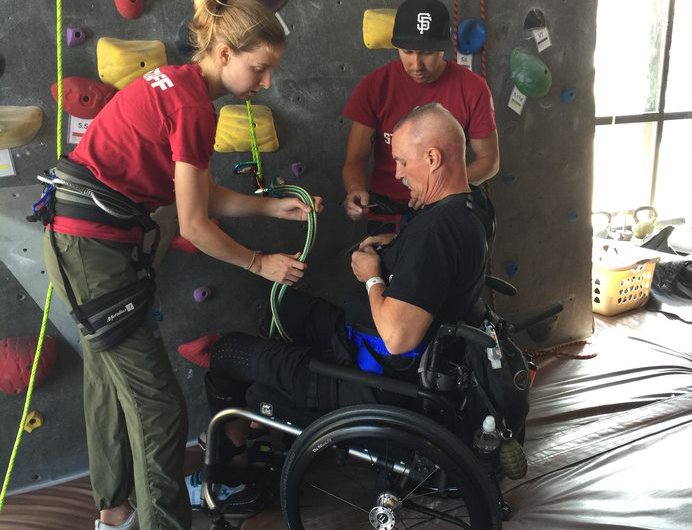
Mark Christianson prepares to climb a wall at Stanford University. (Photo courtesy of Stanford U.)
May 11, 2020
Mike Richman
VA Research Communications
A new study finds that indoor rock climbing appears to offer a “unique array” of physical, social, and psychological benefits for people with disabilities, including those with amputations, spinal cord injury, and traumatic brain injury.
Dr. Elissa Zakrasek, a physical medicine and rehabilitation doctor at the VA Palo Alto Health Care System in California who specializes in spinal cord injury, led the study. She’s in the process of submitting the results for publication.
In surveys of Veterans and non-Veterans with disabilities, Zakrasek and her team found potential therapeutic benefits to adaptive rock and rope climbing, including community connection, confidence building, and muscle strengthening. Those benefits warrant ongoing research, the researchers say.
The findings also highlight the need for more study of physical risks to disabled people who engage in rock and rope climbing, including skin and musculoskeletal injuries. The musculoskeletal system includes joints, ligaments, muscles, nerves, tendons, and structures that support one’s limbs, neck, and back. However, with proper training, equipment, and risk mitigation, the benefits to rock and rope climbing for disabled people most likely outweigh the risks of injury, says Zakrasek, who is also affiliated with Stanford University in California.
“If someone with a disability could potentially benefit from being out in the community and interacting with other people,” she says, “or if they could improve their strength or cardiovascular fitness through climbing, we should know this. These benefits have been reported in non-disabled populations.”
"It takes me to the extreme while not overdoing it."
Zakrasek explains that adaptive rock and rope climbing protocols include extra safety precautions beyond those used in traditional rock climbing, such as a back-up belay system with, for example, two belays per climber. Belaying refers to the process of holding and maintaining tension on one end of a rope that goes over an anchor or at the top of the wall, then down to where it’s secured to the climber. When a climber is on belay, long falls are avoided, and the climber can be carefully lowered back to the ground.
“With these extra precautions, as well as disability-specific education of gym staff, we believe the risk of serious injury, such as new spinal cord injury or brain injury, is incredibly, incredibly small, Zakrasek says. “These types of injuries have not been reported in adaptive climbing literature or by the adaptive climbing community to date.”
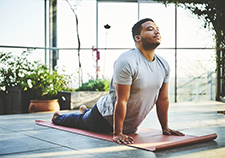
Exercise may be useful treatment option for Veterans with PTSD
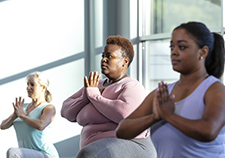
VA researcher aims to help survivors of military sexual trauma with PTSD
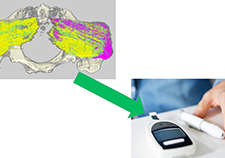
A new way to prevent pressure injuries
Indoor rock and rope climbing has been growing in popularity, with efforts underway to develop an adaptive version of the sport that will make it more accessible to people with disabilities. As a two- to four-limb activity with many options for level of difficulty, rock climbing is highly adaptable. Adaptive climbing sometimes requires specialized harnesses to minimize the risk of skin injury or to provide more core stabilization, as well as a specialized rope set up to create a mechanical advantage system to decrease the strength requirements of participants. Some climbers with disability do not require special modifications.
Research has shown adaptive sports to improve cardiovascular fitness, decrease rates of depression and anxiety, and improve quality of life, personal satisfaction, community integration, and one’s belief in his or her ability to accomplish a task.
A growing number of climbing gyms are offering adaptive climbing programs. Plus, paraclimbing, a form of rock climbing designed for people with impairments, has become a part of international climbing competitions.
Zakrasek first gained interest in the topic when she was a medical student at the University of California, Davis. She met a man who had sustained a spinal cord injury while doing rock climbing. He subsequently became the first person with paraplegia to ascend El Capitan, a rock formation of more than 3,000 feet in height at Yosemite National Park in California.
“I was doing a lot of rock climbing at the time and was blown away by his story and perseverance to continue doing what he loves,” she says. “This person has also made it his career to facilitate rock climbing for all people with disabilities by designing adaptive equipment and techniques. I later met a man with spinal cord injury who was climbing at a local gym without using any adaptive equipment. This made me realize the breadth of climbing possibilities for people with spinal cord injury and other physical limitations.”
Zakrasek initially wanted to compare the health effects of two adaptable climbing strategies: rope ascension and top rope climbing. But she soon learned that people who can climb on a rock wall with a top rope system often have no interest in rope ascension because “it just doesn’t feel like climbing,” she says. Therefore, she adjusted her protocol to see how both forms of climbing could benefit people with disabilities.
In Zakrasek’s study, two types of climbing were available to the participants: indoor top rope climbing and rope ascension climbing. The former is a standard form of rock climbing in which one uses a grip to climb a rock wall while secured with a rope. Rope ascension involves climbing a rope with an ascender bar instead of climbing the wall. It allows for more mechanical assistance through one or more pulley systems and enables climbers with more limited strength or endurance to complete an ascent.
The study was divided into three parts. In the first part, 17 adaptive climbers completed an anonymous on-line survey that was based on their experiences over a 10-week period. Most of the climbers were men, and amputation was the most common disability.
Regarding the climbing benefits:
In individual responses, one respondent said climbing benefited her son with Down syndrome in developing coordination, such as “where to put what hand and what foot next,” and in instilling “motivation, determination, and success.” Another respondent highlighted a change in her confidence and how climbing “made me so blessed to be living to the fullest… it has created more awareness of how I move my feet and body in general.” One respondent attributed functional gains to his climbing, including the ability to “walk farther on my prosthetic.”
One fracture was reported among the participants. But it’s unclear whether that person was reporting a fracture that was caused by rock climbing or noting how the sport helped with recovery.
In part two, the researchers observed and documented all climbing-related injuries over the course of 12 indoor adaptive rock-climbing sessions. They also asked the recreation therapists and inpatient teams to report on any health or injury concerns after the climbing session.
Additionally, the researchers surveyed 16 participants about their experiences in the 12 sessions. The participants had disabilities including traumatic brain injury (TBI), visual impairment, and spinal cord injury.
The results showed that the participants universally enjoyed the climbing experience, and all said they’d be interested in continuing with adaptive climbing. Common themes noted by the climbers included enjoying the camaraderie and the challenge of climbing and having access to a new physical activity or experience. One also highlighted the psychological benefit of getting out of his wheelchair. When asked what they most enjoyed about the experience, the climbers gave such feedback as:
The participants, however, singled out barriers to ongoing participation in climbing, including personal medical problems, the need for specialized equipment, financial concerns, and the lack of an accessible facility, transportation, and a climbing partner.
The third part of the study involved three men—ages 32, 34, and 48—who completed a weekly climbing program. Two of the participants had complete paraplegia from a spinal cord injury, with preserved upper body strength. The other climber had incomplete quadriplegia following a severe infection that led to peripheral neuropathy and four partial limb amputations, including below the left elbow, the right thumb, multiple toes, and below the right knee. He wore a left-hand prosthesis and a right lower-limb prosthesis while climbing. Peripheral neuropathy, a result of damage to the nerves outside the brain and spinal cord, often causes numbness, weakness, and pain, usually in the hands and feet.
The three participants rated their perceived exertion using a scale that measures physical activity intensity level from 6 to 20, with 6 meaning “no exertion at all” and 20 meaning “maximum exertion.” Perceived exertion is how hard a person feels like his or her body is working.
Based on the rating scale, the scores were generally high. But the researchers found no obvious trends over the course of the program. “That was not surprising, as all climbers changed routes, attempted harder routes, or increased speed of climbing as the program progressed,” the researchers write.
Regarding enjoyment of the climbing sessions, all three men reported an eagerness to continue adaptive climbing once the program ended. They also shared common themes of appreciating the challenge of something new and enjoying the exercise. One climber described the activity as “the one thing I looked forward to all week!” Another declared following his first climbing experience: “You gave me a smile today!”
For a future study on rock and rope climbing, Zakrasek foresees a larger group of participants who are not engaged in another physical activity at baseline so everyone would essentially be starting at the same point. They would participate in a climbing program twice a week for 16 weeks, with the researchers comparing pre- and post-measures of fitness. The measurements would include hand and grip strength; range of motion; cardiovascular health markers, such as weight, fat free mass, cholesterol, and VO2 max—the maximum level of oxygen the body can use during a period of intense exercise—and quality of life-mood factors.
“It would be interesting to do a multi-armed prospective randomized study with some participants randomized to climbing, others to a cycling program, and others to standard of care,” she says. “Another study will be crucial to creating disability-specific, therapeutic adaptive climbing protocols that will optimize benefit while minimizing risk.”
The Paralyzed Veterans of America and the Dana and Christopher Reeves Foundation were involved in supporting the research, along with Earth Treks and the Studio Climbing gym.
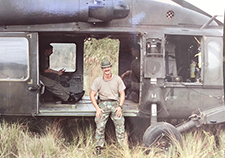
During his days as a Green Beret, Mark Christianson prepares for an air insertion operation in El Salvador. (Photo courtesy of M. Christianson)
Mark Christianson knows all about ascending to great heights. While serving in the military from 1970 to 1991, the Army Green Beret worked as a special forces mountaineer instructor. In one of his assignments, he maneuvered his way through mountainous regions of South America, such as Chile and Argentina, where “climbing was an integral part of our operational mission set,” as he put it.
He didn’t stop after leaving the service, teaching rock climbing to civilian search and rescue teams and military ROTC programs. He was also a certified instructor for the Army mountaineer program in California and for elements of the California National Guard and active-duty military.
While in the military, Christianson also did three tours in Vietnam. Today, he’s partially paralyzed from the diaphragm down because of a spinal cord tumor that his doctors suspect is linked to Agent Orange, the chemical defoliant used by U.S. forces during the Vietnam War. He maintains some movement in his legs.
Nevertheless, Christianson still loves to climb. With excellent cardio and endurance for someone age 67—“I’m not your average 67-year-old man,” he says—he participated in the study led by Dr. Elissa Zakrasek of VA Palo Alto on adaptive rock and rope climbing for people with disabilities (see main story). He ascended as high as 25 feet climbing the rocks. “It was a test and a challenge to me because of the limitations that I’m under and from my experiences in the past,” he says.
In addition to building muscle strength while climbing, Christianson benefited psychologically. Knowing that he once scaled mountains professionally, he realized he can still defy gravity despite his disability.
“Oh, absolutely,” he says. “It’s tremendously empowering to be able to get out and do it. The thing that gives me the most pleasure is watching young able-bodied people look at what you’re able to do. Even though I’m injured, I still have the capacity and capability to get out there and enjoy the sport. Doing so encourages younger kids that have injuries of whatever nature to also get out there and do it. I feel blessed to be able to show that even though I’m injured, I still have the ability to do things that empower you and inspire others.”
If Zakrasek embarks on another adaptive rock-climbing study, Christianson says he’ll eagerly participate.
“Dr. Z is pushing really hard to get our Veterans into this program and expand it throughout the VA for recreation, as well as for psychological benefits for our Vets,” he says. “I’m going to be connecting her with the Green Beret Foundation, which is an outstanding organization in its ability to get Veterans out and about on fishing trips, hunting trips, and things of that nature. It’s another avenue for her to get our Veterans out and active.”
--- Mike Richman
VA Research Currents archives || Sign up for VA Research updates